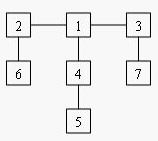http://poj.org/problem?id=1655
| Time Limit: 1000MS | Memory Limit: 65536K | |
| Total Submissions: 9072 | Accepted: 3765 |
Description

Input
Output
Sample Input
1 7 2 6 1 2 1 4 4 5 3 7 3 1
Sample Output
1 2
Source
求树的重心!!
树的重心性质是以该点为根的有根树最大子树的结点数最少,也就是让这树更加"平衡",容易知道这样所有的子树的大小都不会超过整个树大小的一半,所以在树分治时防止树退化成链很有用。。
求树的重心做法是dfs简单的树dp就行。设son[i]表示以i为根的子树的结点数(包括i,叶子结点就是1),那么son[i]就+=sum(son[j])...然后求以i为根的最大结点数就是max(son[j],n-son[i]),n-son[i]是i的"上方结点"的个数。
关于树的重心一些性质:http://fanhq666.blog.163.com/blog/static/81943426201172472943638/
代码:
/**
* @author neko01
*/
//#pragma comment(linker, "/STACK:102400000,102400000")
#include <cstdio>
#include <cstring>
#include <string.h>
#include <iostream>
#include <algorithm>
#include <queue>
#include <vector>
#include <cmath>
#include <set>
#include <map>
using namespace std;
typedef long long LL;
#define min3(a,b,c) min(a,min(b,c))
#define max3(a,b,c) max(a,max(b,c))
#define pb push_back
#define mp(a,b) make_pair(a,b)
#define clr(a) memset(a,0,sizeof a)
#define clr1(a) memset(a,-1,sizeof a)
#define dbg(a) printf("%d\n",a)
typedef pair<int,int> pp;
const double eps=1e-9;
const double pi=acos(-1.0);
const int INF=0x3f3f3f3f;
const LL inf=(((LL)1)<<61)+5;
const int N=20005;
struct node{
int to,next;
}e[N*2];
int head[N];
int son[N]; //son[i]表示以i为根的子树节点个数包括i
int dp[N]; //dp[i]表示以i为根时的最大子树节点数
int tot;
int n;
void init()
{
tot=0;
clr1(head);
}
void add(int u,int v)
{
e[tot].to=v;
e[tot].next=head[u];
head[u]=tot++;
}
void dfs(int u,int pre)
{
son[u]=1;
dp[u]=0;
for(int i=head[u];i!=-1;i=e[i].next)
{
int v=e[i].to;
if(v!=pre)
{
dfs(v,u);
son[u]+=son[v];
dp[u]=max(dp[u],son[v]);
}
}
dp[u]=max(dp[u],n-son[u]);
}
int main()
{
int t;
scanf("%d",&t);
while(t--)
{
scanf("%d",&n);
init();
for(int i=1;i<n;i++)
{
int u,v;
scanf("%d%d",&u,&v);
add(u,v);
add(v,u);
}
dfs(1,0);
int ans1=0,ans2=n+1;
for(int i=1;i<=n;i++)
if(dp[i]<ans2)
{
ans2=dp[i];
ans1=i;
}
printf("%d %d\n",ans1,ans2);
}
return 0;
}
原文:http://blog.csdn.net/neko01/article/details/39940939